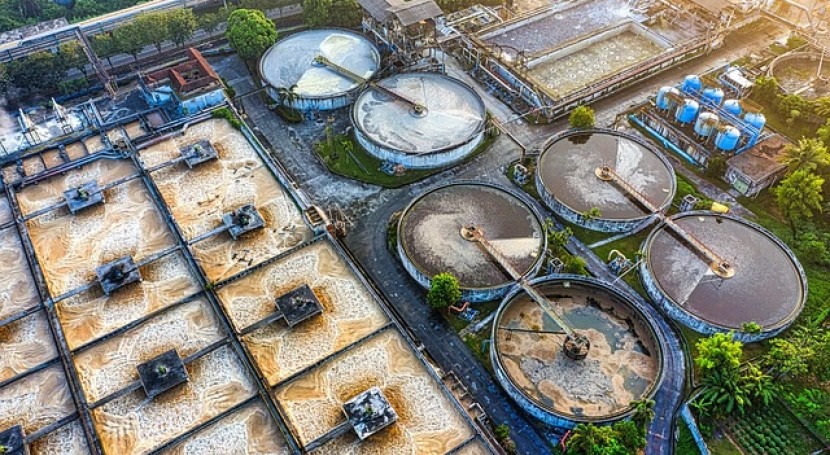Strategic Approaches to Improve Drainage Treatment Effectiveness and Decrease Environmental Effect
In the realm of waste water therapy, the pursuit for improved efficiency and reduced ecological effect is a perpetual challenge that requires calculated services. The integration of innovative treatment technologies, energy-efficient procedures, source healing techniques, boosted nutrient removal methods, and smart surveillance and control systems stands for a multifaceted structure for resolving these pressing concerns.
Advanced Therapy Technologies
Cutting-edge membrane filtration systems have actually changed advanced wastewater therapy processes, substantially enhancing the removal of pollutants. This modern technology has actually proven to be highly effective in getting rid of a wide range of pollutants, consisting of drugs, heavy steels, and natural substances, which are typically testing to remove via typical therapy approaches.
In addition, membrane layer purification systems supply countless benefits over standard therapy techniques. They call for much less area, generate higher-quality effluent, and are more resistant to variations in influent water top quality. Additionally, these systems are highly functional and can be quickly integrated right into existing treatment plants or used as standalone devices for decentralized applications. As the demand for clean water proceeds to climb, the fostering of sophisticated membrane layer filtering innovations is vital to make certain sustainable and reliable wastewater therapy methods.
Energy-Efficient Procedures
The combination of energy-efficient processes in wastewater therapy systems is important for optimizing source use and minimizing operational costs. By implementing energy-efficient modern technologies, treatment plants can considerably decrease their carbon impact and total ecological effect. One key approach to enhancing power effectiveness in wastewater therapy is the use of sophisticated oygenation systems, such as fine bubble diffusers or surface aerators, which can improve oxygen transfer performance and reduce energy usage. Additionally, integrating power recuperation systems, like anaerobic digestion for biogas production or using excess warmth for thermal processes, can assist offset energy demands and advertise sustainability.
Moreover, enhancing procedure control and automation through making use of advanced sensing units and monitoring systems can enhance overall energy efficiency by adjusting procedures in real-time based upon real need and problems. Carrying out power audits and consistently monitoring energy performance indicators are important practices to identify areas for renovation and track energy-saving campaigns properly. Generally, the fostering of energy-efficient processes in wastewater treatment not only benefits the setting yet additionally adds to long-term price savings and functional sustainability.
Source Recuperation Approaches
With an emphasis on maximizing source utilization and sustainability in wastewater therapy systems, the application of source healing techniques becomes a critical aspect in boosting operational efficiency. Source healing strategies in wastewater treatment entail the recognition and extraction of useful resources from the waste stream, thereby transforming what was as soon as considered waste into a useful possession. By executing source healing strategies such as nutrient removal and recuperation, energy generation from raw material, and the production of multiple-use water, wastewater treatment plants can decrease environmental influence while making the most of performance.

Boosted Nutrient Elimination Techniques
Carrying out sophisticated nutrient removal strategies is crucial for enhancing the effectiveness of wastewater therapy systems. One of the crucial techniques utilized for improved nutrient removal is the procedure of biological nutrient removal (BNR), which entails the removal of nitrogen and phosphorus via biological processes.

In enhancement to BNR, progressed treatment approaches such as membrane bioreactors his response (MBRs) and built marshes can also be utilized to improve nutrient elimination efficiency. By incorporating these innovative nutrient removal techniques right into wastewater therapy districts, systems and sectors can successfully minimize nutrient contamination and safeguard the environment.
Smart Monitoring and Control Equipment
Using sophisticated modern technology, the assimilation of wise monitoring and control systems revolutionizes the functional efficiency of wastewater therapy facilities. These systems incorporate sophisticated sensors and information analytics to continuously check crucial parameters such as pH degrees, turbidity, dissolved oxygen, and circulation rates in real-time. By collecting and assessing this information, operators can acquire useful understandings right into the performance of the therapy procedures, enabling aggressive modifications to maximize treatment performance.
Smart tracking and control systems additionally support remote surveillance abilities, permitting operators to accessibility real-time data and control features from off-site locations. This remote access enhances functional versatility and responsiveness, enabling quick treatments in situation of system malfunctions or fluctuations in influent top quality. Moreover, the predictive upkeep abilities of these systems aid protect against devices failings and decrease downtime, ultimately enhancing the total reliability of wastewater therapy procedures (Waste Water Treatment).
Final Thought
In final thought, critical methods such as sophisticated go now therapy innovations, energy-efficient procedures, source recuperation strategies, enhanced nutrient removal methods, and wise tracking and control systems play a crucial role in improving wastewater treatment effectiveness and lessening ecological influence. By implementing these methods, wastewater therapy plants can boost their general performance, reduce energy consumption, recover valuable sources, and make certain conformity with ecological laws. These strategies are crucial for reliable and sustainable wastewater management methods.

In verdict, critical techniques such as sophisticated therapy innovations, energy-efficient processes, resource recuperation methods, improved nutrient removal methods, and smart surveillance and control systems play a vital function in enhancing wastewater treatment effectiveness and decreasing environmental effect.